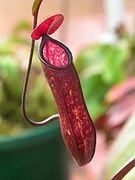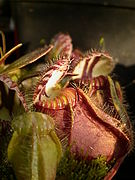
Pitcher plant
About this schools Wikipedia selection
SOS Children have produced a selection of wikipedia articles for schools since 2005. Sponsor a child to make a real difference.
Pitcher plants are carnivorous plants whose prey-trapping mechanism features a deep cavity filled with liquid known as a pitfall trap. It is widely assumed pitfall traps evolved by epiascidiation (infolding of the leaf with the axadial or upper surface becoming the inside of the pitcher), with selection pressure favouring more deeply cupped leaves over evolutionary time. The pitcher trap evolved independently in three eudicot lineages and one monocot lineage, representing a case of convergent evolution. Some pitcher plant families (such as Nepenthaceae) are placed within clades consisting mostly of flypaper traps, indicating that some pitchers may have evolved from the common ancestors of today's flypaper traps by loss of mucilage.
Foraging, flying or crawling insects such as flies are attracted to the cavity formed by the cupped leaf, often by visual lures such as anthocyanin pigments, and nectar bribes. The rim of the pitcher (peristome) is slippery, when moistened by condensation or nectar, causing insects to fall into the trap. Pitcher plants may also contain waxy scales, protruding aldehyde crystals, cuticular folds, downward pointing hairs, or guard-cell-originating lunate cells on the inside of the pitcher to ensure that insects cannot climb out. The small bodies of liquid contained within the pitcher traps are called phytotelmata. They drown the insect, and the body of it is gradually dissolved. This may occur by bacterial action (the bacteria being washed into the pitcher by rainfall) or by enzymes secreted by the plant itself. Furthermore, some pitcher plants contain mutualistic insect larvae, which feed on trapped prey, and whose excreta the plant absorbs. Whatever the mechanism of digestion, the prey items are converted into a solution of amino acids, peptides, phosphates, ammonium and urea, from which the plant obtains its mineral nutrition (particularly nitrogen and phosphorus). Like all carnivorous plants, they grow in locations where the soil is too poor in minerals and/or too acidic for most plants to survive.
Types of pitcher plants
The families Nepenthaceae and Sarraceniaceae are the best-known and largest groups of pitcher plants.
The Nepenthaceae contains a single genus, Nepenthes, containing over 100 species and numerous hybrids and cultivars. In these Old World pitcher plants, the pitchers are borne at the end of tendrils that extend from the midrib of an otherwise unexceptional leaf. The plants themselves are often climbers, accessing the canopy of their habitats using the aforementioned tendrils, although others are found on the ground in forest clearings, or as epiphytes on trees.
In contrast, the New World pitcher plants (Sarraceniaceae), which comprise three genera, are ground-dwelling herbs whose pitchers arise from a horizontal rhizome. In this family, the entire leaf forms the pitcher, whereas in the Nepenthaceae, the pitcher arises from the terminal portion of the leaf. The species of the genus Heliamphora, which are popularly known as marsh pitchers (or erroneously as sun pitchers), have a simple rolled-leaf pitcher, at the tip of which is a spoon-like structure that secretes nectar. They are restricted to areas of high rainfall in South America. The North American genus Sarracenia are the trumpet pitchers, which have a more complex trap than Heliamphora, with an operculum, which prevents excess accumulation of rainwater in most of the species. The single species in the Californian genus Darlingtonia is popularly known as the cobra plant, due to its possession of an inflated "lid" with elegant false-exits, and a forked "tongue", which serves to ferry ants and other prey to the entrance of the pitcher. The species in the genus Sarracenia readily hybridise, making their classification a complex matter.
There are two other families of pitcher plants, but both contain just one or two carnivorous species.
The Cephalotaceae is a monotypic family with but one genus and species, Cephalotus follicularis. This species has a small (2–5 cm) pitcher similar in form to those of Nepenthes. It occurs in only one location in southwestern Australia.
A few species of bromeliads ( Bromeliaceae), such as Brocchinia reducta and Catopsis berteroniana, are known or suspected to be carnivorous. Bromeliads are monocots, and given that they all naturally collect water where their leaves meet each other, and that many collect detritus, it is not surprising that a few should have been naturally selected to develop the habit into carnivory by the addition of wax and downward-pointing hairs.
The Purple pitcher plant, Sarracenia purpurea, is the floral emblem of the province of Newfoundland and Labrador, Canada.
|








